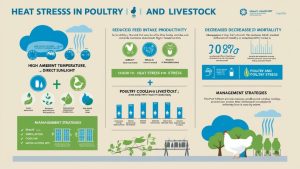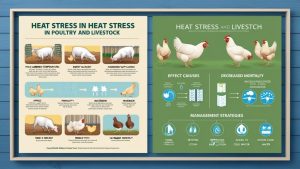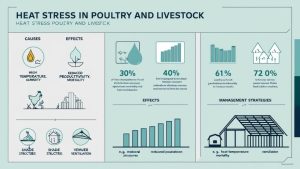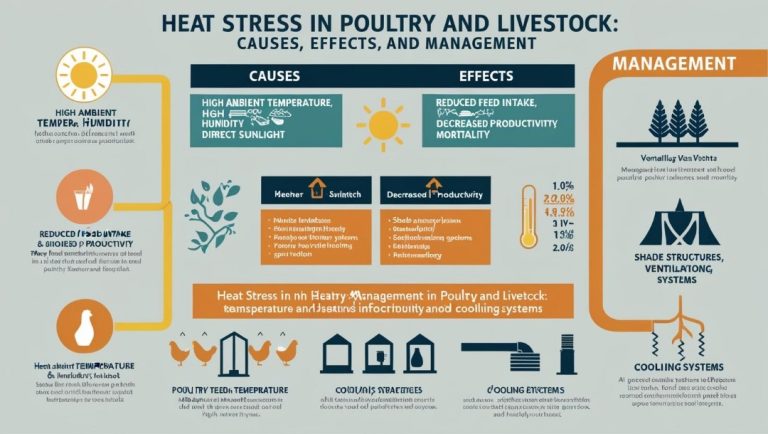Heat stress is a major challenge in poultry and livestock production, especially in tropical and subtropical regions. Rising global temperatures, coupled with high humidity, can severely impact the health, productivity, and welfare of farm animals. Heat stress occurs when animals are unable to dissipate excessive heat from their bodies, leading to physiological and metabolic disturbances.
This article provides a detailed overview of the causes, effects, and management strategies of heat stress in poultry and livestock to help farmers mitigate its impact and improve animal well-being.
Click HERE to join our WhatsApp group
Understanding Heat Stress
a) Causes of Heat Stress
Heat stress occurs when an animal’s heat load exceeds its heat dissipation capacity. The major contributing factors include:
High environmental temperatures: Extreme heat, especially above 30°C (86°F), increases heat accumulation in animals.
High humidity: When humidity levels exceed 60%, animals struggle to cool down through sweating or panting.
Poor ventilation: Limited air circulation in housing facilities worsens heat stress.
Direct solar radiation: Exposure to direct sunlight increases heat absorption.
High stocking density: Overcrowding reduces air movement and increases heat production.
Inadequate water supply: Dehydration exacerbates heat stress.
Metabolic heat production: High-energy diets increase body temperature during digestion.
READ ALSO: Duck Farming for Meat and Egg Production: A Comprehensive Guide
b) How Animals Regulate Heat
Livestock and poultry use various mechanisms to regulate body temperature:
Evaporative cooling: Sweating in cattle and panting in poultry and pigs help release excess heat.
Vasodilation: Expansion of blood vessels helps dissipate heat.
Behavioral adaptation: Seeking shade, reducing feed intake, and increasing water consumption.
When these mechanisms fail, animals experience heat stress, leading to health complications.
Effects of Heat Stress on Poultry and Livestock

a) Poultry
Reduced feed intake: Birds eat less to minimize metabolic heat production, leading to weight loss and poor growth.
Lower egg production: Heat stress reduces egg size, shell quality, and overall laying performance.
Increased water consumption: Birds drink more water, but excessive panting leads to dehydration.
Weakened immune system: Birds become more susceptible to diseases such as Newcastle disease and coccidiosis.
Higher mortality rates: Severe heat stress can cause sudden death due to heat exhaustion.
READ ALSO: Artificial Insemination in Livestock and Poultry
b) Dairy Cattle
Lower milk production: Heat stress reduces feed intake, leading to lower milk yield and quality.
Decreased fertility: Reduced estrus expression and poor conception rates.
Higher risk of mastitis: Heat stress weakens immune function, increasing mastitis cases.
Metabolic disorders: Increased risk of acidosis and ketosis.
c) Beef Cattle
Reduced weight gain: Heat-stressed cattle have lower feed conversion efficiency.
Poor meat quality: Heat stress negatively affects carcass composition and marbling.
d) Pigs
Lower reproductive performance: Reduced sperm quality in boars and irregular estrus in sows.
Higher risk of heat stroke: Pigs lack functional sweat glands and are highly susceptible to heat stress.
Reduced feed efficiency: Poor growth rates and lower carcass yield.
e) Small Ruminants (Sheep and Goats)
Lower wool quality: Heat stress affects wool growth in sheep.
Dehydration and heat exhaustion: Severe cases can lead to mortality.
Lower reproductive success: Reduced conception rates and lower birth weights.
READ ALSO: Artificial Insemination in Livestock and Poultry
Strategies to Prevent and Manage Heat Stress

a) Environmental Modifications
Provide shade: Trees, shade cloths, and artificial shelters reduce heat exposure.
Improve ventilation: Proper airflow in housing systems reduces heat buildup.
Use evaporative cooling: Sprinklers, misters, and foggers help lower ambient temperature.
Adjust housing orientation: Buildings should be positioned to maximize natural airflow and minimize sun exposure.
Reduce stocking density: Avoid overcrowding to enhance airflow and reduce heat production.
b) Nutritional Adjustments
Increase water availability: Provide clean, cool water to prevent dehydration.
Modify feed composition:
Reduce fiber and high-energy feeds to lower metabolic heat production.
Increase dietary fat as an alternative energy source.
Supplement with electrolytes (sodium, potassium) to maintain hydration and prevent imbalances.
Include vitamins (C and E) and antioxidants to reduce oxidative stress.
Feed during cooler periods: Early morning and late evening feeding minimizes heat load.
c) Genetic Selection
Select heat-tolerant breeds: Breeds like Sahiwal cattle, Red Maasai sheep, and Kuroiler chickens are more heat-resistant.
Crossbreeding programs: Mixing high-yielding breeds with indigenous heat-resistant breeds improves adaptability.
d) Behavioral and Management Practices
Observe animals regularly: Monitor for signs of heat stress such as panting, drooling, and lethargy.
Reduce handling during hot hours: Minimize transportation, vaccinations, and weighing during peak heat.
Adjust milking schedules: Milking early in the morning or late in the evening helps reduce stress on dairy cows.
READ ALSO: Essential Proteins for Turkey Growth
Long-Term Solutions to Mitigate Heat Stress

a) Climate-Resilient Farming Practices
Agroforestry: Planting trees within pastures provides natural shade.
Rotational grazing: Avoids overgrazing and maintains a cooler environment.
Water conservation: Installing water-harvesting systems ensures a steady supply of cool drinking water.
b) Research and Technology Development
Genomic selection: Identifying heat-resistant genes to breed climate-resilient livestock.
Precision farming: Using automated cooling systems, temperature sensors, and climate-controlled housing.
Feed innovation: Development of heat-resistant feed formulations and supplements.
c) Policy and Institutional Support
Government assistance: Providing subsidies for cooling systems and heat-resistant breeds.
Farmer education programs: Training farmers on best practices for heat stress management.
Research funding: Investing in climate adaptation strategies for livestock production.
Conclusion
Heat stress poses a serious threat to poultry and livestock production, leading to economic losses and welfare concerns. By implementing environmental modifications, adjusting nutrition, selecting heat-tolerant breeds, and adopting climate-resilient farming practices, farmers can mitigate the negative impacts of heat stress. Long-term solutions, such as research on heat-resistant breeds and innovative feeding strategies, are essential for sustaining livestock production in the face of climate change.
READ ALSO: Blackhead Disease in Turkeys: Causes, Symptoms, Prevention, and Treatment
Blackhead disease, scientifically known as Histomoniasis, is a serious and often fatal condition affecting turkeys. It is caused by the protozoan parasite Histomonas meleagridis, which primarily affects the liver and ceca of infected birds. The disease spreads quickly within flocks and can lead to high mortality rates, making it a significant concern for poultry farmers, especially those raising turkeys…
READ ALSO: Water-Based Feed Formulation for Ducks: A Comprehensive Guide
Water-based feed formulation for ducks is an innovative approach that enhances nutrient absorption, improves digestion, and reduces feed wastage. Ducks naturally consume aquatic plants, insects, and other water-based food sources, making wet feed a practical and efficient option in commercial and small-scale duck farming. This method is particularly beneficial in improving feed efficiency, promoting healthy growth, and optimizing egg production in laying ducks…
Click HERE to join our WhatsApp group

